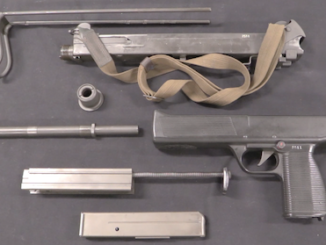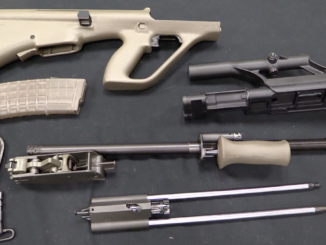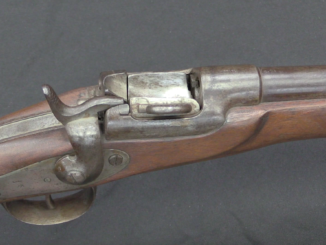In an effort to appeal to American and British military testing commissions, Georg Roth produced a handful of prototype Roth-Krnka pistols in .45 caliber. They used a proprietary cartridge; the 11.5mm Roth (approximately 200 grains at 660 fps, although more powerful versions of the cartridge would be used in other trials pistols later). The gun is a very interesting intermediary design, with the front end of a 1907 Roth-Steyr and the rear end of a Roth-Krnka, complete with exposed hammer.
Related Articles

Submachine Guns
Austria’s Take on the Uzi: Steyr MPi-69

Select-fire Rifles
Steyr StG 77, aka the AUG

Single Shot Rifles

This is the meat & potatoes we come to Forgotten Weapons for. Thank you.
My giant book of Cartridge Conversions has a procedure when no case is available – machining from a brass rod…
Ian’s sight synopsis makes sense. Hatcher had similar thoughts on bore alignment vs. sight alignment in his 1935 book on revolver and pistol shooting. Covers it quite well actually. And well done Ian.
“A Monster Hand Cannon” . . . with .380 KE
Do remember that the intended victim would not be someone hiding behind a rock 100 meters from the user. Any officer using his pistol in anger would be certain that whomever receives a bullet out of the pistol is someone “a hop, skip, and a jump” away, or, simply put, not very far from the pistol’s muzzle. Intended victims include deserters, rioters, and, if the user is a cavalryman, some fool who literally tries to drag the user off his horse (as opposed to bayoneting him to death). I could be wrong.
You seem to be contending that military handguns don’t need to chamber giant magnum cartridges to be effective; I understand and agree. I also understand and agree that there are situations where a mild cartridge could be effective; for example, .380 excels in an M-11/9.
My only disagreement was with the notion that a sub-200ftlb pistol could be considered a “monster hand cannon”, even at the time of this pistol’s introduction (when .45 Colt, .45 ACP, .455 Webley, etc. were common everyday cartridges rather than “monster hand cannons” despite each being significantly more powerful than 11.5mm Roth).
You are correct that the large pistol with mild rounds really isn’t a hand cannon. It’s just a large gun, easy for a user to hold, and authoritative enough to keep unfriendly people at bay without causing a sprained wrist every time it fires.
“A large pistol with mild rounds” can indeed be effective, although Roth’s approach to the mild cartridge seems virtually unique in the smokeless era.
“(…)Roth’s approach(…)”
I am wondering if cartridge ballistic was Roth or Krnka decision? Latter if I am not mistaken published some treatises about fire-arms as KAISERTREU. I have no access of them, but maybe they explain such decision?
“(…)Roth’s approach to the mild cartridge seems virtually unique in the smokeless era.(…)”
I do see some similarity with Schouboe .45 automatic pistol which used very light for caliber bullet http://old.municion.org/Schouboe/45Schouboe.htm as both full-filled “caliber no lesser than .45” requirement yet were different from common ~.45 cartridge of that era.
Interestingly K. Krnka also developed pocket automatic pistol:
http://hungariae.com/RothSau.htm
which fired cartridge milder than 7,65 mm Browning [.32 Auto]
Daweo,
Despite the caliber similarity, I think they’re at opposite ends of the spectrum. The Roth-Krnka mimics blackpowder derringer ballistics, with a heavy bullet at very low velocity. Today when it seems like a new cartridge comes along every month or so, none really duplicate that formula – for good reason: It delivers none of the advantages of full-power bigbores, while recoiling more than medium-caliber cartridges of similar energy.
The Schouboe took the converse approach, similar to today’s non-lead exotic projectiles or even (ballistically) to bottleneck high-velocity cartridges, while technically checking the box for the Army’s .45 requirement. I don’t know whether that was “malicious compliance” on the inventor’s part, a failure of the “task and purpose” principle by the Army, or some combination thereof.
@Mike:
both cartridge were made lesser than of typical .45 Auto – bullet mass in case of Schouboe pistol, velocity in case of Roth-Krnka. I would say former predated TRÈS HAUTE VITESSE bullets http://www.quarryhs.co.uk/THV.htm
Due to its high velocity, the Schouboe’s energy is practically identical to the ACP’s. I’m not really a fan per se; Schouboe met the technical letter but not the spirit of the spec, and took his concept too far. Within reason, though, light and fast has physics on its side. My preferred carry load is .357 SIG, 90gr JHP at 1850fps: all else being equal, that’s 1 1/4x the recoil of the Roth-Krnka for 3.5x the KE!
I had never seen those THVs before; they look like onion domes. Do you think the Patriarch approves? 😉
“(…)when .45 Colt, .45 ACP, .455 Webley, etc. were common everyday cartridges rather than “monster hand cannons” despite each being significantly more powerful than 11.5mm Roth(…)”
Especially taking into account fact that in that time in Austria so-called Montenegrin revolver were produced across Austria-Hungary:
http://old.municion.org/Montenegrin/Montenegrin.htm
Daweo,
Now THAT was a monster!
The book authored by Krnka under the pseudonym Kaisertreu (meaning loyal subject of the [Austrian] Kaiser) was titled “Die pricipiellen Eigenschaften der automatischen Feuerwaffen” (The basic properties of automatic firearms) and published in 1902.
While it does contain a lot of technical description, the book is rife with agitation against his enemy von Mannlicher and propaganda of Krnka’s design. His base line is that long recoil designs are the one and only type of an acceptable automatic weapon. Anything else is inferior.
In the same year the author Robert B. Jentzsch set some of the facts straight in a book titled “Ist Kaisertreu wahrheitstreu?” (meaning: Is Kaisertreu as loyal to the truth as he is to the Kaiser?)
Sorry for the typo. It should read “Die principiellen …”
“(…)1902(…)His base line is that long recoil designs are the one and only type of an acceptable automatic weapon. Anything else is inferior.(…)”
Well eventually Krnka himself apparently make revision of his view as in 1920s he developed weapons utilizing short-recoil principle namely:
ZB-Krnka 1925 http://www.vhu.cz/exhibit/puska-zb-krnka-1925/
samostříl No. 2 http://www.vhu.cz/exhibit/automaticka-puska-samostril-krnka-vyrobni-cislo-2/
samostříl No. 3 http://www.vhu.cz/exhibit/automaticka-puska-samostril-krnka-vyrobni-cislo-3/
When .45 Roth was introduced (the 1901 British trials), .45 ACP would not be introduced for another three years and .455 Webley for another twelve. The .45 Long Colt was just re-entering service in 1901 after having been replaced by the .38 Long Colt in 1892.
The alternatives to this round would have been things like .38 ACP, 7.63mm Mannlicher, and 9mm Largo, which were all still more energetic than the early .45 Roth.
The bracket for the rear sight is clearly offset, but from the sight picture at 5:11 in the video [https://youtu.be/AhHTfOq1Ggw?t=311], it looks to me like the rear sight notch is still centered on the barrel/frame of the gun (visible again from above at 6:33 [https://youtu.be/AhHTfOq1Ggw]). Are we sure the sight notch is actually off-center? If it’s not actually off-center, perhaps the asymmetric sight bracket is just a quirk of the prototype frame casting or maybe some extra clearance for pressing down the stripper clip plunger with a right-hand thumb?
Hahaha! I love analysis by YouTube!
lt seems you are right… The rear sight notch seems not offset but the bracket is… Firearms moves from the sight pictures in fractions of distances both vertical and horizonal planes but, horizotal move occurs only multi barreled or badly made weapons… A 700 grams of 9mm pistol with ten centimeters barrel recoils backward approximately one milimeter at the time when the bullet leaving the bore. This of course for a handgun of unitary construction that is single shot or similar made… No holding hand can prevent such an instant move through inertia and the gun rotates around the axis of center of weight and generaly the muzzle slightly rises up deviating the bullet from supposed aim… Gun sights are made with calculated corrections taken from results from countless trials of moderate users… lMHO…
Form follows function- Its also a handy club. Stylish also… Its missing something though. To me, I think it is engraving. Un bar aux Folies Bergère…
To check zero without shooting, mankind has come up with something.
https://www.quora.com/Are-laser-bore-sighters-an-effective-way-to-calibrate-or-zero-your-weapon-at-least-as-far-as-horizontal-accuracy-is-concerned